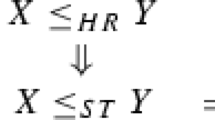Abstract
A distribution function \(F\) is a generalized mixture of the distribution functions \(F_1,\ldots ,F_k\) if \(F=w_1 F_1+\ldots +w_k F_k\), where \(w_1,\ldots ,w_k\) are some real numbers (weights) which should satisfy \(w_1+\ldots +w_k=1\). If all the weights are positive, then we have a classical finite mixture. If some weights are negative, then we have a negative mixture. Negative mixtures appear in different applied probability models (order statistics, estimators, coherent systems, etc.). The conditions to obtain stochastic comparisons of classical (positive) mixtures are well known in the literature. However, for negative mixtures, there are only results for the usual stochastic order. In this paper, conditions for hazard rate and likelihood ratio comparisons of generalized mixtures are obtained. These theoretical results are applied in this paper to study distribution-free comparisons of coherent systems using their representations as generalized mixtures. They can also be applied to other probability models in which the generalized mixtures appear.




Similar content being viewed by others
References
Agrawal A, Barlow RE (1984) A survey of network reliability and domination theory. Oper Res 32:478–492
Baggs GE, Nagaraja HN (1996) Reliability properties of order statistics from bivariate exponential distributions. Commun Stat Theory Methods 12:611–631
Balakrishnan N, Cramer E (2008) Progressive censoring from heterogeneous distributions with applications to robustness. Ann Inst Stat Math 60:151–171
Balakrishnan N, Cramer E (2014) The art of progressive censoring: applications to reliability and quality. Birkhäuser, New York
Balakrishnan N, Xie Q (2007a) Exact inference for a simple step-stress model with type-I hybrid censored data from the exponential distribution. J Stat Plan Inference 137:3268–3290
Balakrishnan N, Xie Q (2007b) Exact inference for a simple step-stress model with type-II hybrid censored data from the exponential distribution. J Stat Plan Inference 137:2543–2563
Balakrishnan N, Xie Q, Kundu D (2009) Exact inference for a simple step-stress model from the exponential distribution under time constraint. Ann Inst Stat Math 61:251–274
Barlow RE, Proschan F (1975) Statistical theory of reliability and life testing. holt, rinehart and winston, New York
Block HW, Li Y, Savits TH (2003) Initial and final behavior of failure rate functions for mixtures and systems. J Appl Probab 40:721–740
Borgonovo E (2010) The reliability importance of components and prime implicants in coherent and non-coherent systems including total-order interactions. Eur J Oper Res 204:485–495
David HA, Nagaraja HN (2003) Order statistics, 3rd edn. Wiley, New York
Everitt BS, Hand DJ (1981) Finite mixture distributions. Chapman and Hall, New York
Franco M, Balakrishnan N, Kundu D, Vivo JM (2014) Generalized mixtures of weibull components. Test 23:515–535
Glaser RE (1980) Bathtub and related failure rate characterizations. J Am Stat Assoc 75:667–672
Kamps U, Cramer E (2001) On distributions of generalized order statistics. Statistics 35:269–280
Kochar S, Mukerjee H, Samaniego FJ (1999) The “signature” of a coherent system and its application to comparison among systems. Naval Res Logist 46:507–523
Kotz S, Balakrishnan N, Johnson NL (2000) Continuous multivariate distributions. Volume 1: models and applications. Wiley, New York
Navarro J (2008) Likelihood ratio ordering of order statistics, mixtures and systems. J Stat Plan Inference 138:1242–1257
Navarro J, Eryilmaz S (2007) Mean residual lifetimes of consecutive k-out-of-n systems. J App Probab 44:82–98
Navarro J, Balakrishnan N, Samaniego FJ (2008a) Mixture representations of residual lifetimes of used systems. J Appl Probab 45:1097–1112
Navarro J, Guillamon A, Ruiz MC (2009) Generalized mixtures in reliability modelling: applications to the construction of bathtub shaped hazard models and the study of systems. Appl Stoch Models Bus Ind 25:323–337
Navarro J, Pellerey F, Di Crescenzo A (2015) Orderings of coherent systems with randomized dependent components. Eur J Oper Res 240:127–139
Navarro J, Rubio R (2010) Comparisons of coherent systems using stochastic precedence. Test 19:69–486
Navarro J, Rubio R (2011) A note on necessary and sufficient conditions for ordering properties of coherent systems with exchangeable components. Naval Res Logist 58:478–489
Navarro J, Rubio R (2012) Comparisons of coherent systems with non-identically distributed components. J Stat Plan Inference 142:1310–1319
Navarro J, Ruiz JM, Sandoval CJ (2007) Properties of coherent systems with dependent components. Commun Stat Theory Methods 36:175–191
Navarro J, Samaniego FJ, Balakrishnan N, Bhattacharya D (2008b) On the application and extension of system signatures in engineering reliability. Naval Res Logist 55:313–327
Navarro J, Shaked M (2006) Hazard rate ordering of order statistics and systems. J Appl Probab 43:391–408
Samaniego FJ (1985) On the IFR closure theorem. IEEE Trans Reliab 34:69–72
Samaniego FJ (2007) System signatures and their applications in engineering reliability. Springer, New York
Samaniego FJ, Navarro J (2016) On comparing coherent systems with heterogeneous components. Adv Appl Probab 48(1) (to appear)
Shaked M, Shanthikumar JG (2007) Stochastic orders, 2nd edn. Springer, New York
Wu JW (2001) Characterizations of generalized mixtures of geometric and exponential distributions based on upper record values. Stat Papers 42:123–133
Wu JW, Lee WC (1998) Characterization of generalized mixtures of exponential distribution based on conditional expectation of order statistics. J Jpn Stat Soc 28:39–44
Acknowledgments
I would like to thank the editors and the anonymous reviewers for several helpful suggestions. This research was supported in part by Ministerio de Economía y Competitividad under Grant MTM2012-34023-FEDER.
Author information
Authors and Affiliations
Corresponding author
Rights and permissions
About this article
Cite this article
Navarro, J. Stochastic comparisons of generalized mixtures and coherent systems. TEST 25, 150–169 (2016). https://doi.org/10.1007/s11749-015-0443-5
Received:
Accepted:
Published:
Issue Date:
DOI: https://doi.org/10.1007/s11749-015-0443-5




